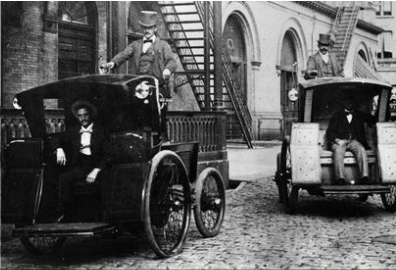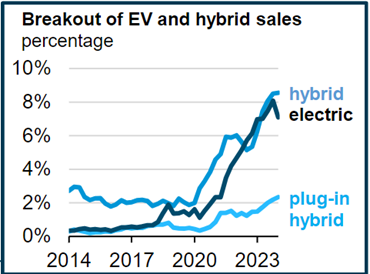The electronic vehicle (EV) industry is hitting a bit of a speed bump. Tesla sales have slowed while legacy auto manufacturers have recently delayed EV investments. Some newer electric vehicle manufacturers such as Fisker have gone bankrupt.
Much to my surprise this is not the industry’s first foray into electric vehicles. In the early days of automobiles, most were in fact electric. One of the first “automobiles” was a battery powered horseless carriage and in the 1830s batteries weren’t even rechargeable. In 1837 an electric locomotive was built in Scotland that could go 1.5 miles at 4mph while towing 6 tons but the batteries had to be replaced once used. The railway workers saw the electric locomotive as a threat to their livelihood working with steam engines and destroyed it, calling it a “Devil” machine. By the 1860s batteries could be recharged and in 1888 a chemist in Des Moines, Iowa built a carriage that could go 50 miles on a single charge with a top speed of 14mph. It was a huge hit at the 1893 World’s Fair in Chicago.

By the 1900s electric vehicles were selling better than the dirty and difficult to drive (with shifting gears) gas automobiles. New York, Boston & Baltimore had a fleet of “Electrobats” serving as taxis. They could go 25 miles on a single charge and reach a top speed of 20mph. In 1896 the Electrobats even beat gas powered cars in a 5-mile race. To address charging times the company had a battery swap station where a used battery could be quickly replaced with a fully charged one. However, the company went bankrupt in 1907 due to expanding too quickly.
In 1908 Henry Ford rolled out the Model T making the Electrobat bankruptcy seem very prophetic. Despite being loud, dirty, hard to start with the hand crank, and hard to drive with a manual transmission the Model T quickly surpassed electric vehicles due to the lower cost. By 1912 a Model T cost $650 while an electric vehicle sold for $1,750. By 1923 Model T’s were sold for less than $300. Ironically, Henry Ford’s wife drove electric vehicles until 1914, but after the electric starter was invented in 1912, she also joined the ranks of the gas powered. Another reason gas vehicles overtook electric was because gasoline was widely available and cheap while electricity was not, only 40% of Americans had electricity at home in 1923.
100 years later and electric vehicles are once again making a comeback. Battery technology has progressed substantially. Tesla launched the roadster in 2008 with a 200-mile range while the current Model S released in 2015 has a 300 mile range.

Consumers are still hesitant for largely the same reasons as 100 years ago, cost and range. In response governments are offering large tax credits to buyers of EV’s and to companies investing in EV production. However hybrid vehicles are growing faster (5%) than fully electric vehicles(2.7%). Telsa’s sales have slowed but part of it is due to consumers buying different brands. Telsa’s EV market share recently dipped below 50% while Ford & GM have taken share. The euphoric headlines for the collapse of oil companies and gas powered cars may have been overblown, the switch to EV and hybrid is continuing, although at a slower pace than expected 3 years ago.
Andrew Otten,
Associate Portfolio Manager


